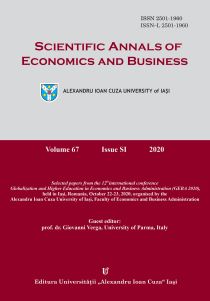Automated vs Manual Content Analysis – A Retrospective Look
DOI:
https://doi.org/10.47743/saeb-2020-0025Keywords:
content analysis, automated qualitative research, manual qualitative research, sentiment analysisAbstract
Content Analysis, which is a part of qualitative analysis, has mainly been studied in scientific articles from health and medicine domains. With the emerge of social networks, there are new opportunities for content analysis, which can be used to analyse user generated content, from various sources. Nevertheless, the companies are investing millions of dollars in content analysis, which is often known as sentiment analysis. The discussion in this article helps to understand the main concepts of content analysis for those interested in the domain of qualitative analysis, with the help of automated and manual qualitative research. The overall conclusion is that automated qualitative analysis is dependent on how accurate is the tool used and this feature can be checked with the help of manual qualitative analysis.
JEL Codes - O33; O35References
Alla, K., Oprescu, F., Hall, W. D., Whiteford, H. A., Head, B. W., and Meurk, C. S., 2018. Can automated content analysis be used to assess and improve the use of evidence in mental health policy? A systematic review. Systematic Reviews, 7(1), 194. http://dx.doi.org/10.1186/s13643-018-0853-z
Atwebembire, M., 2015. Sentiment Analysis: Uses in Business. (BCom), University of Cape Town. (ATWMAR001)
Bengtsson, M., 2016. How to plan and perform a qualitative study using content analysis. NursingPlus Open, 2, 8-14. http://dx.doi.org/10.1016/j.npls.2016.01.001
Berthon, P., Pitt, L., Kietzmann, J., and McCarthy, I. P., 2015. CGIP: Managing Consumer-Generated Intellectual Property. California Management Review, 57(4), 43-62. http://dx.doi.org/10.1525/cmr.2015.57.4.43
Byrne, M. D., Jordan, T. R., and Welle, T., 2013. Comparison of manual versus automated data collection method for an evidence-based nursing practice study. Applied Clinical Informatics, 4(1), 61-74. http://dx.doi.org/10.4338/ACI-2012-09-RA-0037
Cambria, E., Schuller, B., Xia, Y., and Havasi, C., 2013. New avenues in opinion mining and sentiment analysis. IEEE Intelligent Systems, 28(2), 15-21. http://dx.doi.org/10.1109/MIS.2013.30
Clement, J., 2020. Number of social network users worldwide from 2010 to 2021. Statista. https://www.statista.com/statistics/278414/number-of-worldwide-social-network-users/.
Creswell, J. W., 2013. Qualitative inquiry and research design: Choosing among five approaches. Thousand Oaks, CA: ed. Sage (Atlanta, Ga.).
Elo, S., Kääriäinen, M., Kanste, O., Pölkki, T., Utriainen, K., and Kyngäs, H., 2014. Qualitative Content Analysis: A Focus on Trustworthiness. SAGE Open, 4(1), 2158244014522633. http://dx.doi.org/10.1177/2158244014522633
Fan, W., and Gordon, M. D., 2014. The power of social media analytics. Communications of the ACM, 57(6), 74-81. http://dx.doi.org/10.1145/2602574
Fondevila-Gascon, J. F., Carreras-Alcalde, M., and Del Olmo-Arriaga, J. L., 2012. Impacto de las tecnologias de la informacion y la comunicacion en la eleccion de Universidad: El caso de Internet y las redes sociales. Edutec. Revista Electrónica De Tecnología Educativa, 39(March), a195. http://dx.doi.org/10.21556/edutec.2012.39.378
Jayasanka, R. A. S. C., Madhushani, E.R., Marcus, I. A. A. U., Aberathne, I. and Premaratne, S.C. 2014. Sentiment analysis for social media. International Journal of Advanced Research in Computer Science and Software Engineering, 3(7), 216-222.
Kyngäs, H., Elo, S., Polkki, T., Kaariainen, M., and Kanste, O., 2011. The use of content analysis in Finnish nursing science research. Hoitotiede, 23(2), 138-148.
Luo, A., 2019. What is content analysis and how can you use it in your research. Scribbr. https://www.scribbr.com/methodology/content-analysis/.
Murphy, R., 2018. Local Consumer Review Survey | Online Reviews Statistics & Trends. Brightlocal. https://www.brightlocal.com/research/local-consumer-review-survey/.
Pyett, P. M., 2003. Validation of qualitative research in the "real world". Qualitative Health Research, 13(8), 1170-1179. http://dx.doi.org/10.1177/1049732303255686
Ribarsky, W., Xiaoyu Wang, D., and Dou, W., 2014. Social media analytics for competitive advantage. Computers & Graphics, 38, 328-331. http://dx.doi.org/10.1016/j.cag.2013.11.003
Thomas, E., and Magilvy, J. K., 2011. Qualitative rigor or research validity in qualitative research. Journal for Specialists in Pediatric Nursing, 16(2), 151-155. http://dx.doi.org/10.1111/j.1744-6155.2011.00283.x
Thorne, S., 2000. Data analysis in qualitative research. EBN notebook. https://ebn.bmj.com/content/ebnurs/3/3/68.full.pdf
Zitnik, M., 2012. Using sentiment analysis to improve business operations. XRDS: Crossroads. 18(4), 42-43. http://dx.doi.org/10.1145/2173637.2173655
Downloads
Published
How to Cite
Issue
Section
License
Copyright (c) 2020 SCIENTIFIC ANNALS OF ECONOMICS AND BUSINESS

This work is licensed under a Creative Commons Attribution-NonCommercial-NoDerivatives 4.0 International License.
All accepted papers are published on an Open Access basis.
The Open Access License is based on the Creative Commons license.
The non-commercial use of the article will be governed by the Creative Commons Attribution-NonCommercial-NoDerivatives 4.0 International License as currently displayed on https://creativecommons.org/licenses/by-nc-nd/4.0
Under the Creative Commons Attribution-NonCommercial-NoDerivatives license, the author(s) and users are free to share (copy, distribute and transmit the contribution) under the following conditions:
1. they must attribute the contribution in the manner specified by the author or licensor,
2. they may not use this contribution for commercial purposes,
3. they may not alter, transform, or build upon this work.













